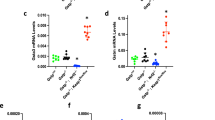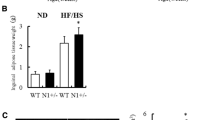Abstract
Transcription factor FoxO1 promotes hepatic glucose production. Genetic inhibition of FoxO1 function prevents diabetes in experimental animal models, providing impetus to identify pharmacological approaches to modulate this function. Altered Notch signaling is evident in tumorigenesis, and Notch antagonists are in clinical testing for application in cancer. Here we report that FoxO1 and Notch coordinately regulate hepatic glucose metabolism. Combined haploinsufficiency of FoxO1 and Notch1 markedly raises insulin sensitivity in diet-induced insulin resistance, as does liver-specific knockout of the Notch transcriptional effector Rbp-Jκ. Conversely, Notch1 gain-of-function promotes insulin resistance in a FoxO1-dependent manner and induces glucose-6-phosphatase expression. Pharmacological blockade of Notch signaling with γ-secretase inhibitors raises insulin sensitivity after in vivo administration in lean mice and in obese, insulin-resistant mice. The data identify a heretofore unknown metabolic function of Notch and suggest that Notch inhibition is beneficial in diabetes treatment, in part by helping to offset excessive FoxO1-driven hepatic glucose production.
This is a preview of subscription content, access via your institution
Access options
Subscribe to this journal
Receive 12 print issues and online access
$209.00 per year
only $17.42 per issue
Buy this article
- Purchase on Springer Link
- Instant access to full article PDF
Prices may be subject to local taxes which are calculated during checkout






Similar content being viewed by others
Change history
01 December 2023
A Correction to this paper has been published: https://doi.org/10.1038/s41591-023-02695-9
References
Accili, D. Lilly lecture 2003: the struggle for mastery in insulin action: from triumvirate to republic. Diabetes 53, 1633–1642 (2004).
Kahn, S.E. et al. Glycemic durability of rosiglitazone, metformin, or glyburide monotherapy. N. Engl. J. Med. 355, 2427–2443 (2006).
Kim-Muller, J.Y. & Accili, D. Cell biology. Selective insulin sensitizers. Science 331, 1529–1531 (2011).
Haeusler, R.A., Kaestner, K.H. & Accili, D. FoxOs function synergistically to promote hepatic glucose production. J. Biol. Chem. 285, 35245–35248 (2010).
Nakae, J. et al. Regulation of insulin action and pancreatic beta-cell function by mutated alleles of the gene encoding forkhead transcription factor Foxo1. Nat. Genet. 32, 245–253 (2002).
Nakae, J., Park, B.C. & Accili, D. Insulin stimulates phosphorylation of the forkhead transcription factor FKHR on serine 253 through a Wortmannin-sensitive pathway. J. Biol. Chem. 274, 15982–15985 (1999).
Altomonte, J. et al. Inhibition of Foxo1 function is associated with improved fasting glycemia in diabetic mice. Am. J. Physiol. Endocrinol. Metab. 285, E718–E728 (2003).
Matsumoto, M., Pocai, A., Rossetti, L., Depinho, R.A. & Accili, D. Impaired regulation of hepatic glucose production in mice lacking the forkhead transcription factor Foxo1 in liver. Cell Metab. 6, 208–216 (2007).
Fortini, M.E. Notch signaling: the core pathway and its posttranslational regulation. Dev. Cell 16, 633–647 (2009).
Dufraine, J., Funahashi, Y. & Kitajewski, J. Notch signaling regulates tumor angiogenesis by diverse mechanisms. Oncogene 27, 5132–5137 (2008).
Weinmaster, G. & Kopan, R. A garden of Notch-ly delights. Development 133, 3277–3282 (2006).
Zong, Y. et al. Notch signaling controls liver development by regulating biliary differentiation. Development 136, 1727–1739 (2009).
Loomes, K.M. et al. Bile duct proliferation in liver-specific Jag1 conditional knockout mice: effects of gene dosage. Hepatology 45, 323–330 (2007).
Xue, Y. et al. Embryonic lethality and vascular defects in mice lacking the Notch ligand Jagged1. Hum. Mol. Genet. 8, 723–730 (1999).
Oka, C. et al. Disruption of the mouse RBP-J kappa gene results in early embryonic death. Development 121, 3291–3301 (1995).
Kitamura, T. et al. A Foxo/Notch pathway controls myogenic differentiation and fiber type specification. J. Clin. Invest. 117, 2477–2485 (2007).
Postic, C. & Magnuson, M.A. DNA excision in liver by an albumin-Cre transgene occurs progressively with age. Genesis 26, 149–150 (2000).
Das, I. et al. Notch oncoproteins depend on γ-secretase/presenilin activity for processing and function. J. Biol. Chem. 279, 30771–30780 (2004).
Nakae, J., Kitamura, T., Silver, D.L. & Accili, D. The forkhead transcription factor Foxo1 (Fkhr) confers insulin sensitivity onto glucose-6-phosphatase expression. J. Clin. Invest. 108, 1359–1367 (2001).
Wang, J. et al. Effects of adenovirus-mediated liver-selective overexpression of protein tyrosine phosphatase-1b on insulin sensitivity in vivo. Diabetes Obes. Metab. 3, 367–380 (2001).
Rand, M.D. et al. Calcium depletion dissociates and activates heterodimeric notch receptors. Mol. Cell. Biol. 20, 1825–1835 (2000).
Wolfe, M.S. γ-Secretase in biology and medicine. Semin. Cell Dev. Biol. 20, 219–224 (2009).
van Es, J.H. et al. Notch/γ-secretase inhibition turns proliferative cells in intestinal crypts and adenomas into goblet cells. Nature 435, 959–963 (2005).
Milano, J. et al. Modulation of notch processing by γ-secretase inhibitors causes intestinal goblet cell metaplasia and induction of genes known to specify gut secretory lineage differentiation. Toxicol. Sci. 82, 341–358 (2004).
Samuel, V.T. et al. Targeting foxo1 in mice using antisense oligonucleotide improves hepatic and peripheral insulin action. Diabetes 55, 2042–2050 (2006).
Accili, D. & Arden, K.C. FoxOs at the crossroads of cellular metabolism, differentiation, and transformation. Cell 117, 421–426 (2004).
Huang, A. et al. Functional silencing of hepatic microsomal glucose-6-phosphatase gene expression in vivo by adenovirus-mediated delivery of short hairpin RNA. FEBS Lett. 558, 69–73 (2004).
Chopra, A.R. et al. Absence of the SRC-2 coactivator results in a glycogenopathy resembling Von Gierke's disease. Science 322, 1395–1399 (2008).
Horton, J.D., Goldstein, J.L. & Brown, M.S. SREBPs: activators of the complete program of cholesterol and fatty acid synthesis in the liver. J. Clin. Invest. 109, 1125–1131 (2002).
Kim, J.J. et al. FoxO1 haploinsufficiency protects against high-fat diet-induced insulin resistance with enhanced peroxisome proliferator-activated receptor gamma activation in adipose tissue. Diabetes 58, 1275–1282 (2009).
Nakae, J. et al. Forkhead transcription factor FoxO1 in adipose tissue regulates energy storage and expenditure. Diabetes 57, 563–576 (2008).
Nakae, J. et al. The forkhead transcription factor Foxo1 regulates adipocyte differentiation. Dev. Cell 4, 119–129 (2003).
Berg, A.H., Combs, T.P., Du, X., Brownlee, M. & Scherer, P.E. The adipocyte-secreted protein Acrp30 enhances hepatic insulin action. Nat. Med. 7, 947–953 (2001).
Pajvani, U.B. et al. Structure-function studies of the adipocyte-secreted hormone Acrp30/adiponectin. Implications fpr metabolic regulation and bioactivity. J. Biol. Chem. 278, 9073–9085 (2003).
Woo, H.N., Park, J.S., Gwon, A.R., Arumugam, T.V. & Jo, D.G. Alzheimer's disease and Notch signaling. Biochem. Biophys. Res. Commun. 390, 1093–1097 (2009).
Purow, B. Notch inhibitors as a new tool in the war on cancer: a pathway to watch. Curr. Pharm. Biotechnol. 10, 154–160 (2009).
Moellering, R.E. et al. Direct inhibition of the NOTCH transcription factor complex. Nature 462, 182–188 (2009).
Fujikura, J. et al. Notch/Rbp-j signaling prevents premature endocrine and ductal cell differentiation in the pancreas. Cell Metab. 3, 59–65 (2006).
Paik, J.H. et al. FoxOs are lineage-restricted redundant tumor suppressors and regulate endothelial cell homeostasis. Cell 128, 309–323 (2007).
Hosaka, T. et al. Disruption of forkhead transcription factor (FOXO) family members in mice reveals their functional diversification. Proc. Natl. Acad. Sci. USA 101, 2975–2980 (2004).
Krebs, L.T. et al. Notch signaling is essential for vascular morphogenesis in mice. Genes Dev. 14, 1343–1352 (2000).
Plum, L. et al. The obesity susceptibility gene Cpe links FoxO1 signaling in hypothalamic pro-opiomelanocortin neurons with regulation of food intake. Nat. Med. 15, 1195–1201 (2009).
Lin, H.V. et al. Divergent regulation of energy expenditure and hepatic glucose production by insulin receptor in agouti-related protein and POMC neurons. Diabetes 59, 337–346 (2010).
Collins, Q.F. et al. Epigallocatechin-3-gallate (EGCG), a green tea polyphenol, suppresses hepatic gluconeogenesis through 5′-AMP-activated protein kinase. J. Biol. Chem. 282, 30143–30149 (2007).
Schmoll, D. et al. Regulation of glucose-6-phosphatase gene expression by protein kinase Bα and the forkhead transcription factor FKHR. Evidence for insulin response unit-dependent and -independent effects of insulin on promoter activity. J. Biol. Chem. 275, 36324–36333 (2000).
Kitamura, Y.I. et al. FoxO1 protects against pancreatic β cell failure through NeuroD and MafA induction. Cell Metab. 2, 153–163 (2005).
Acknowledgements
This work was supported by US National Institutes of Health grants DK57539 (D.A.), DK084583 (U.B.P.), DK63608 (Columbia Diabetes and Endocrinology Research Center), HL062454 (J.K.) and DK76169 (Yale Mouse Metabolic Phenotyping Center). We thank D. Schmoll (Sanofi-Aventis) for the G6pc-luciferase constructs, members of the Accili, Kitajewski and Shulman laboratories for insightful discussion of the data, and A. Flete, T. Kolar and T. Lu for technical support.
Author information
Authors and Affiliations
Contributions
U.B.P. designed and performed experiments, analyzed data and wrote the manuscript. C.J.S., A.L.B. and V.T.S. performed experiments and analyzed data. G.I.S., J.K. and D.A. designed the studies, analyzed the data and wrote the manuscript.
Corresponding author
Ethics declarations
Competing interests
The authors declare no competing financial interests.
Supplementary information
Supplementary Text and Figures
Supplementary Figures 1–6 and Supplementary Tables 1–5 (PDF 776 kb)
Rights and permissions
About this article
Cite this article
Pajvani, U., Shawber, C., Samuel, V. et al. Inhibition of Notch signaling ameliorates insulin resistance in a FoxO1-dependent manner. Nat Med 17, 961–967 (2011). https://doi.org/10.1038/nm.2378
Received:
Accepted:
Published:
Issue Date:
DOI: https://doi.org/10.1038/nm.2378
This article is cited by
-
ZFYVE28 mediates insulin resistance by promoting phosphorylated insulin receptor degradation via increasing late endosomes production
Nature Communications (2023)
-
Amelioration of high-fat diet (HFD) + CCl4 induced NASH/NAFLD in CF-1 mice by activation of SIRT-1 using cinnamoyl sulfonamide hydroxamate derivatives: in-silico molecular modelling and in-vivo prediction
3 Biotech (2022)
-
LKB1 on POMC neurons affect the formation of diet-induced obesity by regulating the expression of HDAC1
Genes & Genomics (2022)
-
Role of insulin action in the pathogenesis of diabetic complications
Diabetology International (2022)
-
Maladaptive regeneration — the reawakening of developmental pathways in NASH and fibrosis
Nature Reviews Gastroenterology & Hepatology (2021)



